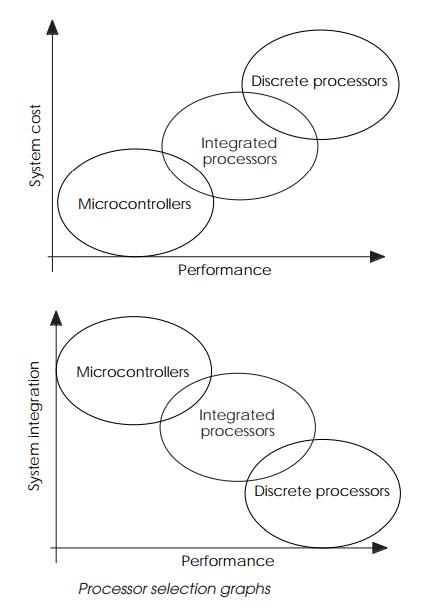Chapter: Embedded Systems Design : Embedded processors
Choosing a processor
Choosing a processor
So far , the main processor types used in embedded
systems along with various examples have been dis-cussed. There are very many
types available ranging in cost, processing power and levels of integration.
The question then arises concerning how do you select a processor for an
embedded system?
The two graphs show the major trends with processors. The first plots
system cost against performance. It shows that for the highest performance
discrete processors are needed and these have the highest system cost. For the
lowest cost, microcontrollers are the best option but they do not offer the
level of performance that integrated or discrete processors offer. Many use the
8 bit accumulator processor architecture which has now been around for over 20
years. In between the two are the integrated processors which offer medium
performance with medium system cost.
The second graph shows the trend towards system integra-tion against
performance. Microcontrollers are the most inte-grated, but as stated
previously, they do not offer the best perform-ance. However, the ability to
pack a whole system including memory, peripherals and processor into a single package
is attrac-tive, provided there is enough performance to perform the work
required.
The problem comes with the overlap areas where it be-comes hard to work
out which way to move. This is where other factors come into play.
Does it have enough performance?
A simple question to pose but a difficult one to answer. The problem is
in defining the type of performance that is needed. It may be the ability to
perform integer or floating point arithmetic operations or the ability to move
data from one location to another. Another option may be the interrupt response
time to allow data to be collected or processed.
The problem is that unless the end system is understood it is difficult
to know exactly how much performance is needed. Add to this the uncertainty in
the software programming overhead, i.e. the performance loss in using a high
level language compared to a low level assembler, and it is easy to see why the
answer is not straightforward.

In practice, most paper designs assume that about 20–40% of the
processor performance will be lost to overheads in terms of MIPs and
processing. Interrupt latencies can be calculated to give more accurate figures
but as will be explained in Chapter 7, this has its own set of problems and
issues to consider.
Related Topics